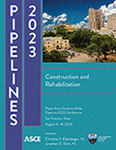Box-Tunneling Saves the Day from Utility Congestion
Publication: Pipelines 2023
ABSTRACT
Washington, DC, is a small but historic city with old and abandoned infrastructure. There is also a lot of construction with older buildings being renovated and modernized, capital improvement projects throughout the city, and some new buildings being constructed. Most of this construction will require new underground utilities and abandonment of old ones. Given the small size of the city at 68 mi2 and all the construction being performed, one of the many challenges you will face when performing construction work, particularly excavation, is utility congestion. Many times, other utilities or infrastructure conflicts with the utility you are trying to repair. When the utilities are above and in the way of the utility you are trying to repair, you’ll have to get creative with your repair approach. Such was the case at 529 14th St. NW, where there was no direct access to a broken 10″ lateral servicing the National Press Building due to several utilities in the way and little clearance between them. The 10″ lateral was 19 ft deep, meaning that with all the utilities in the way and little clearance, traditional excavation and shoring would have been very challenging. DC Water first reached out to the owners of the utilities in conflict to see if they can be moved to allow easy access for excavation. After being unsuccessful with contacting some of the utility owners and getting others to temporarily relocate their utility, DC Water directed its contractor, Spiniello Companies, to hand-excavate and expose the utilities. During excavation, Spiniello uncovered even more unmarked utilities, again, with little spacing between them. DC Water had Spiniello backfill the excavation knowing that it will be difficult to excavate deeper and practically no avenue to install shoring. The next approach was to excavate adjacent to the initial hole and then dig toward the broken lateral. Again, Spiniello encountered more utilities. Ultimately, DC Water decided to have Spiniello backfill the second excavation and seek other options. Knowing that performing traditional excavation would require a large footprint on a busy arterial roadway and a complicated shoring system, DC Water decided to look for other alternatives. One of those options, box-tunneling, became attractive because the broken lateral terminated at a manhole about 10 ft from where the lateral was broken. DC Water’s other contractor, Anchor Construction, dug a 3 ft by 5 ft box-tunnel from inside the manhole using hand tools, shoring along the way, until they reached the broken pipe. Anchor was able to make repairs to the sewer lateral, rebuild the manhole wall, and fill the tunnel with flowable fill. This time and cost saving approach required no restoration. Since all work was performed from inside the manhole, the work zone was small and the impact to traffic was minimal. Box tunneling truly saved the day.
Get full access to this article
View all available purchase options and get full access to this chapter.
Information & Authors
Information
Published In
History
Published online: Aug 10, 2023
ASCE Technical Topics:
Authors
Metrics & Citations
Metrics
Citations
Download citation
If you have the appropriate software installed, you can download article citation data to the citation manager of your choice. Simply select your manager software from the list below and click Download.
